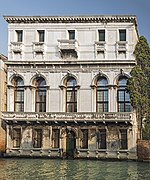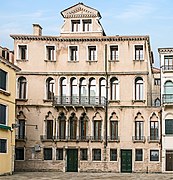Dolfin
Dolfin (also Delfino or Delfin ) is the name of a Venetian patrician family that was one of the twelve so-called "apostolic" families, as it is a branch of the Gradenigo family . This made her one of the most respected families in the Republic of Venice (see: Patriciate of Venice ). In the 19th century was the sex of higher nobility of the Habsburg monarchy belonging to the Kingdom of Lombardy-Venetia , 1817, it had received the Austria-Italian nobility confirmation and 1819 or 1820 the Austrian title of count, and served the Emperor of Austria and. a. in high yard batches , e.g. B. Leonhard and Johann Baptist Count Dolfin since 1838 as chamberlain , while the Empress Count Leonhard (Leonardos) wife and since 1825 Star Cross Order Lady , Lucretia Dolfin, née. Countess Boldù, appointed lady of the palace in 1839 . In 1841 Leonardo Dolfin from Venice was awarded the nobility of the Austrian imperial state.

history
After Bortolo Giovanni Dolfin, the family first appeared in the year 703. However, it only becomes tangible in the archives with a Giovanni Dolfin who appears in 991 as a witness in a document with which five salt pans were sold to the monastery of San Michele di Brondolo . A Giovanni Dolfin, perhaps the same, appears in a judgment (bando) of 998 against men who started a fight in the Doge's Palace , and the same name appears in a list of those who paid tithing (decima) under Doge Pietro II Orseolo .
Another early piece of news, albeit a century later, appears to the Dolfin in 1094 when the relics of St. Markus were found. A Domenico or a Zuane Dolfin is said to have rediscovered this in the St. Mark's Basilica , as Marin Sanudo the Younger narrates, and as a kind of reward the Dolfin received the evangelist's ring.
In 2006 Dorit Raines put forward the thesis that the Dolfin family had formed one of the great clans of Venice with the Gradenigo family by 1240 , when the extremely wealthy long-distance trader Gregorio had made himself independent of the Gradenigo as the head of the Dolfin. In the Cronicha dela nobil cità de Venetia e dela sua provintia et destretto by Giovanni Dolfin it is explained that the family from Mazzorbo named themselves after a palace (called 'cha'), thus “de cha Dolfin”. This name has become independent and under “Griguol Dolfin da San Chanzian” ( San Canciano is meant ) the Dolfin have separated from the common family tradition. Giovanni Sanudo confirms the latter version : “Dolfim; sono do casade; una portano uno dolfin el ‟altra tre dolfini; da Torzello; uno sier Greguòl levò il dolfim solo ”(Dolfino, are two houses; the relatives of one carry a dolphin, the other three, from Torcello). Starting in 1240, on the initiative of a Gregorio, the Dolfin changed their coat of arms, their stemma , which originally only carried one dolphin on a blue and silver background, but now three dolphins.
As Podestà of Treviso, a Jacopo Dolfin had a palace built in the city in 1268. A Gregorio Dolfin, Baiulus in Armenia , was the addressee of the letter from Doge Pietro Gradenigo informing him that the Baiamonte Tiepolo conspiracy had come about (1310). The Dolfin played an essential role in suppressing the rebellion. With Giovanni Dolfin (1356–1361) the family provided one of the Doges, but Venice lost Dalmatia to Hungary during his reign and also got into a financial crisis. Nonetheless, other family members rose to many of the key positions of power. A Benedetto Dolfin became Podestà in Murano in 1363, a position that Jacopo Dolfin filled in 1398. There the family also owned one of their numerous palaces, and one of them, Bianco Dolfin, owned a house there.

The Dolfin managed to build a sizeable library , and Giorgio (Zorzi) Dolfin (1396-1458), who worked for several years as a supervisor (Proveditore) over the financial management of the authorities, wrote a chronicle of the city . A copy of this has been preserved in the Biblioteca Nazionale Marciana . The Dolfin family, who also appeared as patrons in the 15th century, maintained contacts with important artists of their time, such as Jacopo Bellini , who created a triptych of the name saint in the chapel of Lorenzo Dolfin between 1460 and 1464 in the church of Santa Maria della Carità (today's gallery dell'Accademia ).
Jacopo Dolfin acted as envoy of the republic, but was better known for the famous painting by Titian. The admiral of the same name, who, as envoy, negotiated the treaty of 1265 with the Byzantines, who had succeeded in regaining Constantinople four years earlier, may have contributed more to the rise of the family.
However, not only in the secular but also in the spiritual realm, a number of members of the family succeeded in becoming bishop or patriarch, nuncio or cardinal . Among these were Zaccaria Dolfin (1527–1583), cardinal and from 1554 to 1556 apostolic nuncio at the imperial court in Vienna , then various members of Dolfin with the first name Giovanni, such as Giovanni Dolfin (Bishop of Brescia) (1528–1584), who was also bishop of Torcello and papal nuncio, then the cardinals Giovanni Dolfin (cardinal, 1545) (1545–1622) and Giovanni Dolfin (cardinal, 1617) (1617–1699), finally Daniele Dolfin (cardinal, 1653) (1653–1704), who was also Archbishop of Brescia. In addition, the Dolfin occupied the Patriarchal Chair of Aquileia several times, such as with Dionisio (1663-1734) or Daniele (1684-1762) and his namesake (1688-1762), who was not only Patriarch, but also Archbishop of Udine and Cardinal.
City palaces
- Palazzo Dolfin on the Grand Canal, Cannaregio
- Palazzetto Dolfin on the Grand Canal, Cannaregio
- Palazzo Dolfin on the Grand Canal, San Polo
- Palazzo Dolfin Manin on the Grand Canal, San Marco
- Palazzo Bollani Dolfin in Castello
- Palazzo Secco Dolfin Dorsoduro
Web links
Remarks
- ^ GHdA , Adelslexikon , Volume II, Limburg an der Lahn 1974, p. 518 f.
- ^ Johann Josef Schindler: Wapen Gallery of the Higher Nobility of the Entire Provinces of the Austrian Imperial State , Volume 6, Vienna 1836. ( digitized version ), Der Oesterreich Beobachter , 1838, p. 1326 . Court and State Manual of the Austrian Empire , Vienna 1847, p. 97 .
- ↑ Francesco Schröder: Repertorio genealogico delle famiglie confermate nobili e dei titolati nobili esistenti nelle provincie Venete , Volume 2, Venice 1831, p. 463 .
- ↑ Court and State Schematism of the Austrian Empire , Vienna 1841, p. 71 .
- ↑ Non-profit and exhilarating house calendar for the Austrian Empire , Vienna 1839, p. 49 .
- ↑ Joseph Kudler and Moritz von Stubenrauch : Journal for Austrian Legal Scholarship and Political Law , Volume 3, Vienna 1841, p. 529 .
- ↑ Roberto Cessi (ed.): Documenti relativi alla storia di Venezia anteriori al Mille , Padua 1943, vol. 2, p. 163, n.81.
- ↑ Roberto Cessi (ed.): Documenti relativi alla storia di Venezia anteriori al Mille , Padua 1943, vol. 2, p. 140, n. 70.
- ↑ Marin Sanudo: De origine, situ et magistratibus , section Queste sono altre degne reliquie in diverse chiesie : "l‟ anello de San Marco, l ‟hebbero quelli da ca 'Dolfin" ( Angela Caracciolo Aricò (ed.): Marin Sanudo il giovane: De origine, situ et magistratibus urbis Venetae ovvero La Città di Venezia (1493–1530) , Milan 1980, p. 49, expanded new edition by the Centro di Studi Medievali e Rinascimentali “ Emmanuele Antonio Cicogna ”, 2011).
- ^ Dorit Raines: L'invention du mythe aristocratique. L'image de soi du patriciat vénitien au temps de la Sérénissime , Istituto Veneto di Scienze, Lettere ed Arti , Venice 2006.
- ↑ Cronicha dela nobil cità de Venetia et dela sua provintia et destretto (Biblioteca Nazionale Marciana It. VII, 794 (= 8503)), f. 43v (according to information from Chiara Frison: La Chronica di Giorgio Dolfin (Origini – 1458) nel contesto culturale della Venezia del sec. XV , tesi di dottorato, Venice 2011, p. 6 f.).
- ↑ Gabriella Delfini, Fabio Nassuato: Il Palazzo dei trecento a Treviso. Storia, arte, conservazione , Skira, Milan 2008, p. 44.
- ↑ Vincenzo Zanetti: Guida di Murano e delle celebri sue fornaci vetrarie. Corredata di note storiche, artistiche, biografiche, cronologiche, con tavole prospettiche , Venice 1866, p. 339 f.
- ↑ Vincenzo Zanetti: Guida di Murano e delle celebri sue fornaci vetrarie. Corredata di note storiche, artistiche, biografiche, cronologiche, con tavole prospettiche , Venice 1866, p. 72.
- ↑ Vincenzo Zanetti: Guida di Murano e delle celebri sue fornaci vetrarie. Corredata di note storiche, artistiche, biografiche, cronologiche, con tavole prospettiche , Venice 1866, p. 279.
- ^ Titian - Jacopo Dolfin - LA County Museum of Art, Los Angeles (c. 1532) .







